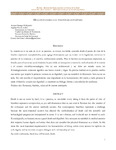
Please use this identifier to cite or link to this item:
http://ricaxcan.uaz.edu.mx/jspui/handle/20.500.11845/964Full metadata record
| DC Field | Value | Language |
|---|---|---|
| dc.contributor.other | 0000-0002-7699-1432 | es_ES |
| dc.coverage.spatial | Global | es_ES |
| dc.creator | Noriega Maldonado, Adriana | - |
| dc.creator | García Avilés, Angélica | - |
| dc.date.accessioned | 2019-04-29T19:31:05Z | - |
| dc.date.available | 2019-04-29T19:31:05Z | - |
| dc.date.issued | 2018-07-08 | - |
| dc.identifier | info:eu-repo/semantics/publishedVersion | es_ES |
| dc.identifier.issn | 2594-0430 | es_ES |
| dc.identifier.uri | http://ricaxcan.uaz.edu.mx/jspui/handle/20.500.11845/964 | - |
| dc.description | Death is not an event byitself, it is a process, an inevitable event, taking it from the point of view of bioethics represents complexities, as you add dimensions that do not exist in Mexican law: the practice of the euthanasiaand the suicide medically assisted. For contemporary bioethics represents a challenge because the socio-historical context has allowed the medicalization of death and the scientific and technological progress are incorporated in scene. It is not a disease, and it should not be treated as such. Etymologically, euthanasia means a good death and dignified. It is necessary to establish in medical practice that respects human dignity and action that does not consider the physical dimension as a whole. In this sense the most important requirement is the humanization of dying; assists every person the right to die with dignity and to maintain an open dialogue and a relationship of trust.Key words: euthanasia, bioethics, will for early death. | es_ES |
| dc.description.abstract | La muerte no es un acto en sí, es un proceso, un evento inevitable, asumirla desde el punto de vista de la bioética representa complejidades, pues agrega dimensiones que no existen en la legislación mexicana: la práctica de la eutanasia y el suicidio medicamente asistido. Para la bioética contemporánea representa un desafío pues el contexto socio histórico ha permitido se incorporen a escena la medicalización de la muerte y el avance científico-tecnológico. No es una enfermedad y no debe ser tratada como tal. Etimológicamente, eutanasia significa una buena muerte y digna. Es preciso instituir en la práctica médica una acción que respete la persona humana en su dignidad y que no considere la dimensión física como un todo. En este sentido el requerimiento más importante es la humanización del morir; a toda persona le asiste el derecho a morir con dignidad y a mantener un diálogo abierto y una relación de confianza. | es_ES |
| dc.language.iso | spa | es_ES |
| dc.publisher | Universidad Autónoma de Zacatecas | es_ES |
| dc.relation | http://revistas.uaz.edu.mx/index.php/ibnsina/article/view/455 | es_ES |
| dc.relation.ispartof | http://revistas.uaz.edu.mx | es_ES |
| dc.relation.uri | generalPublic | es_ES |
| dc.rights | Atribución-NoComercial-CompartirIgual 3.0 Estados Unidos de América | - |
| dc.rights.uri | http://creativecommons.org/licenses/by-nc-sa/3.0/us/ | - |
| dc.source | Revista IBN SINA, Año 9, Vol. 22222. | es_ES |
| dc.subject.classification | HUMANIDADES Y CIENCIAS DE LA CONDUCTA [4] | es_ES |
| dc.subject.other | Eutanasia | es_ES |
| dc.subject.other | Voluntad Anticipada | es_ES |
| dc.subject.other | suicidio medicamente asistido | es_ES |
| dc.title | De la Eutanasia a la voluntad anticipada | es_ES |
| dc.type | info:eu-repo/semantics/article | es_ES |
| Appears in Collections: | *Documentos Académicos*-- UA Medicina | |
Files in This Item:
| File | Description | Size | Format | |
|---|---|---|---|---|
| Eutanasia.pdf | 368,12 kB | Adobe PDF |  View/Open |
This item is licensed under a Creative Commons License
